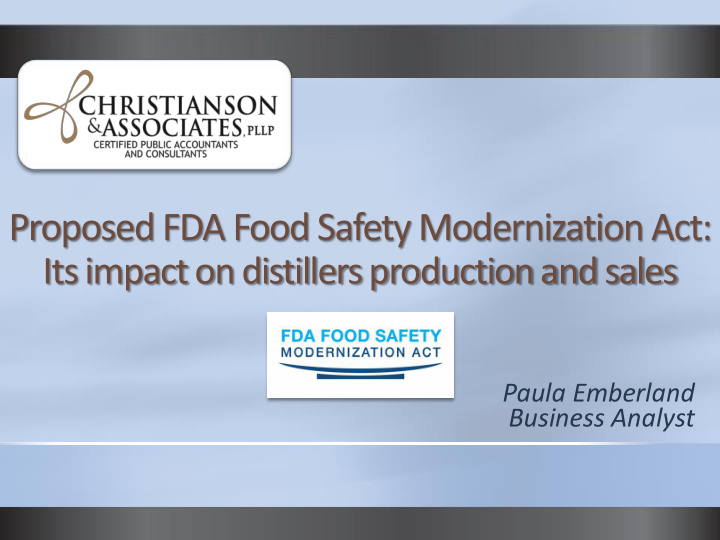



Proposed FDA Food Safety Modernization Act: Its impact on distillers production and sales Paula Emberland Business Analyst
History of the FDA 1927 1949 1969 & 1973 Bureau of Chemistry FDA begins becomes 2 entities: FDA Publishes 1862 Food, Drug & “Procedures for the administering sanitation programs Beginning of Insecticide and appraisal of the Bureau of Bureau of Chemistry Toxicity of Chemicals and food processing regulations Chemistry & Soils in Food” 1906 1939 1952 2011 Pure Food First Food FDA Consumer FDA – FSMA and Drugs Standards Consultants reform to safety Act passed issued for appointed in authority canned each field tomatoes district
Food Safety Legislation Key Facts Every year, 1 out of 6 people in US (48 million) suffer from a foodborne illness. 128,000 are hospitalized and 3,000 die. Passed by Congress on December 21, 2010 Preventive controls Proactive verses Reactive approach Science based standards for safe production of fruits and vegetables New ability to hold food companies accountable for preventing contamination Inspection and Compliance Inspection resources in a risk-based manner Innovating in inspection approach to be efficient and effective utilizing existing resources
Food Safety Legislation Key Facts - Cont Imported Food Safety Requires importers to verify supplier activities Authorizes FDA to refuse imported food Authorizes FDA to require certification based on risk based criteria that food is in compliance with food safety requirements Provides importers incentive to voluntarily take additional safety measures to expedite shipment reviews Response For first time, FDA will have authority to recall all food products Legislation Enhanced Relationships Recognizes need to strengthen existing collaboration among all food safety agencies – Federal, state, local, territorial, tribal and foreign.
Background of FSMA Signed into law January 4, 2011 by President Obama Embraces preventing a food safety system and recognizes the need for a global approach to food and feed safety. FDA proposed three additional rules that are foundational to the this preventive approach. Preventive controls for human food and animals Standards for produce safety Foreign Supplier Verification Program for importers
CGMPs and Preventive Controls for Animals FDA proposed rule breaks down into two areas: Current Good Manufacturing Practices (CGMPs) Preventive Controls for food for animals focuses on preventing problems in order to improve safety of these products. Applies to domestic and imported animal food including: Pet Food Animal Feed Ingredient Processing & Raw Materials
What types of facilities are covered With some exceptions, the proposed rule on CGMPs and preventive controls for food for animals would apply to the following facilities: Manufacture Process Pack Hold Required to register as a food facility under section 415 of the FD&C Act. (Does not apply to farms manufacturing food for own animals or other food facilities not required to register).
New Current Good Manufacturing Practices Similar safety requirements to human food CGMP regulations: Hygienic personnel practices and training Facility operations, maintenance, and sanitation Equipment and utensil design, use, and maintenance Processes and controls Warehousing and distribution
Hazard Analysis & Risk-Based Preventive Controls Each facility would be required to prepare and implement a written food safety plan which includes the following: Hazard analysis Risk-Based Preventive controls Recall Plan Monitoring Corrective actions Verification Recordkeeping
• Proposed rule, Current Good Manufacturing Practice and Hazard Analysis and Risk-Based Preventive Controls for Food for Animals, is published in the Federal Register. • Additional Tools: Guidance documents within 6 months of final rule publication. • Received during comment period will be reviewed by FDA and proposed rule will be revised based on comments prior to issuing a final rule. http://www.regulations.gov or www.fda.gov/fsma
FSMA Dates FDA required reregistration of all feed, ingredient and pet food facilities by January 31, 2013. Make sure your plant has re-registered. Next reregistration Oct 1 - Dec 31, 2014 Proposed rule announcement was on October 29,2013 120 day comment period after publication June 17, 2014, FDA reopened comment period due to comments received for an additional 60 days Final rule to be issued by August 30, 2015 Effective 60 days after the final rule is publish Compliance Dates for CGMPs and PC Large and other facilities: 12 months post publication of final rule Small (less than 500 employees): 2 years Very Small: 3 years
What products are covered in “animal food” and therefore fall under proposed rules? a) Livestock feed b) Pet food c) Ingredients and Raw Materials d) Co-Products from human food e) All of the Above
Does our plant need trained qualified individual(s)? True or False True The training required for a qualified individual can be via a course with standardized curriculum OR through on the job experience to develop and apply a food safety system.
What types of hazards (natural or unintentionally introduced) must included in the hazard analysis? a) Radiological b) Chemical c) Biological d) Physical e) All of the Above
Paula Emberland Business Analyst pemberland@christiansoncpa.com 320.441.5544
Recommend
More recommend